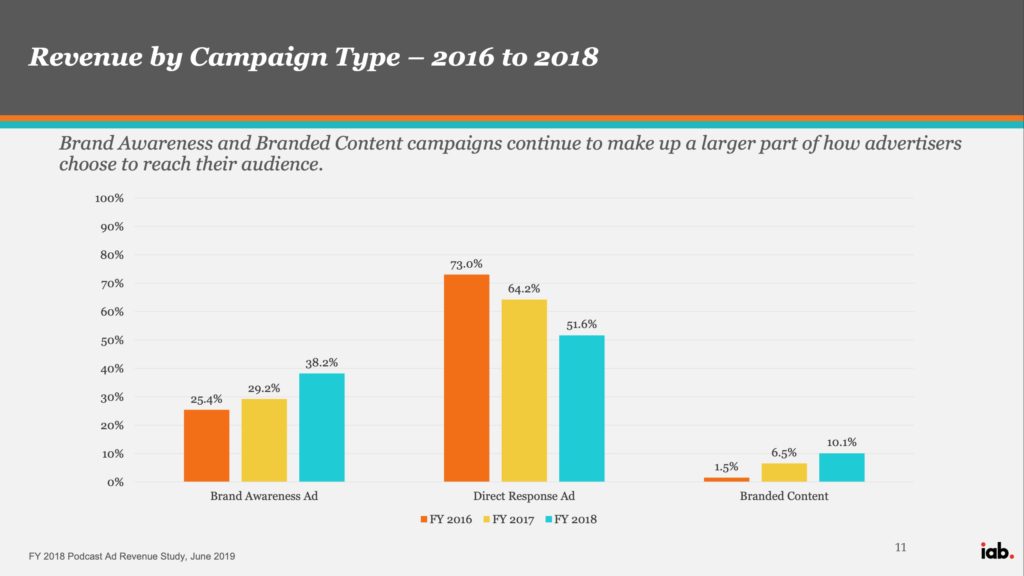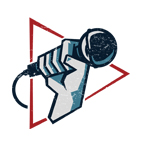Earlier this month, the IAB (Internet Advertising Bureau) and PwC (Pricewaterhouse Coopers) released their third annual Podcast Ad Revenue study. Once again, there was lots of good news for podcasters. Many will focus on the 53% increase in year-over-year podcast advertising revenue — from $314 million in 2017 to $479 million in 2018. The growth is certainly impressive.

By comparison, Kagan reports that the radio industry’s revenue growth was basically flat at 1.1%. Of course, it’s flat at $17.8 billion (with a ‘b’). But in many ways, it’s unfair to compare the two industries. After all, one has been around for more than a century while the other has been around for little over a decade. It’s natural that the mature industry is larger but not growing at a fast pace, while the young industry is smaller but expanding rapidly. That’s the nature of, well, everything.
The question most radio broadcasters — as well as entrepreneurs and venture capitalists — are asking themselves is how they can get in on that growth. Many will assume that the answer is the same for all broadcasters, but I believe the answer is different for different radio companies, depending largely on their size and resources. The temptation, of course, is to go with what we know: create a hit that attracts a large audience and stick ads in the middle of it. But this is much easier when you’re competing against a few dozen other radio stations in your market, most of which have similar staff and budgets sizes to your own. When you’re competing against hundreds of thousands of other podcasts, some of which may be far better resourced or have nationally known hosts, it’s much harder to compete for an audience.

Moreover, it’s not enough to simply produce one hit podcast. Marc Maron and Joe Rogan may generate enough revenue to provide a comfortable living for themselves and a small number of staff members, but when you’re a large company with lots of employees, it takes more; you need to churn out hit after hit after hit to keep the lights on. For radio companies with a large national footprint, this may be feasible. For smaller regional or stand-alone broadcasters, it’s a steep climb.
Compound that with another possible wrinkle: Programmatic advertising. According to the IAB report, the percentage of programmatic ads currently being run in podcasts is tiny — only 1.3%, up from 0.7% in 2017. But as the number of podcasts produced continues to increase, I suspect that a shift towards programmatic advertising will inevitably follow. Sure, there will probably always be premium shows that can be sold individually, but those will be few and far between. Most sizable advertisers will want to place their ads on a large number of podcasts without having to actually listen to all of those podcasts, so programmatic advertising will increase and, as it does, CPMs will drop. This is essentially what happened in the blogging world, and I suspect it will happen with podcasting as well.
All of this is why, when I speak to most radio companies, I’m bearish on podcast advertising revenues, and I strike a cautionary note when talking about it. Yet I am bullish on podcasts as a source of revenue for radio broadcasters overall, largely because I think there’s a fantastic opportunity in a different stream of revenue: branded podcasts.

A branded podcast is a podcast created for a company to engage with its customers. John Deere, Nike, Trader Joe’s, Jack Daniels, and eBay are just a few of the companies that have embraced branded podcasts. It’s only a matter of time before local companies start expressing interest in podcasts as part of their marketing strategy as well. These companies won’t have in-house audio experts capable of producing top-notch podcasts…but radio stations do. Many of the skills needed to produce a 60-second ad or host a successful morning show are the same needed to create a compelling podcast.
Radio stations not only have the tools to produce high quality podcasts, but also to promote them with on-air ads, an email database, a social media following, a mobile app with thousands of installs, and a street team. This gives radio stations an advantage that even local audio production houses or marketing agencies don’t have.
The IAB reports that only 10.1% of podcast revenue comes from branded podcasts, but that’s up from 6.5% in 2017 and 1.5% in 2016 — more than a six-fold increase in just two years. It is likely to continue growing from there, which is an opportunity for radio.

The biggest advantage that branded podcasts have over the advertise-in-a-hit model is that with branded podcasts, you don’t start production until after the sale has been made. With advertising, you usually need to produce the podcast first. (A handful may be sold on a trailer or concept alone, but these will be the exceptions.)
Recently, Fred Jacobs and I spoke to the staff of a small radio company about the state of podcasting. During my talk, I laid out the case for focusing on branded podcasts. Later that very same day, they emailed us to report that they closed a deal to produce a podcast for a local client that they pitched after our presentation. Even I was shocked by how quick they managed to close the sale. Yet it reaffirms my belief: I am bullish on branded podcasts for radio.
 We will host a session on branded podcasts as part of our Broadcasters Meet Podcasters track at the Podcast Movement conference in August. If you’d like to learn more about how your radio station can generate revenue from branded podcasts, be there.
We will host a session on branded podcasts as part of our Broadcasters Meet Podcasters track at the Podcast Movement conference in August. If you’d like to learn more about how your radio station can generate revenue from branded podcasts, be there.
- A Simple Digital Treat to Thank Your Radio Listeners This Thanksgiving - November 13, 2023
- Interview Questions When Hiring Your Radio Station’s Next Digital Marketing Manager - November 6, 2023
- A Radio Conversation with ChatGPT: Part 2 – Promotions - October 30, 2023





As a news/talk station, what I’ve done with success is sell a 30 minute radio show/podcast that airs in a weekend time slot.
We get hundreds of dollars for each weeks show, it gets airtime in a weekend time slot and is archived for the client to use in their own promotional and marketing outreach. I personally have launched a self-help guru/author who has been doing a weekly show for 18 months and also a financial planner who is 9 months in so far.
Both happen to be women and both are self hosted and prerecorded at our studios.
Thanks, Scott! Yes, the concept of selling airtime isn’t new for a lot of news/talk stations, who have done it with weekend time for decades. Podcasting simply presents an opportunity to make that show available on-demand, too. Glad to hear you’re having success with it!